Archify Connect: ECOPact




Archify Live is our web series that responds to the increasing demand for virtual learning and networking. Our latest session was held on the 31st of January 2024 and was presented by Holcim. Below is a transcript of the presentation.
Our topic today will be ECOPact by Holcim.
Okay, so as I said, it's, it's all about ECOPact, which is Holcim, low carbon concrete.
You know, how did we come up with the name, ECOPact, obviously, Eco. But Holcim globally had made a pact to get to absolute net zero by 2050. So, it was important for us to have that as part of the brand the name. You know, we've signed up to science-based targets initiatives and had our 2030 30 targets and 2050 targets, both validated. So, we're very keen, very, it's very much part of every single conversation we'd have, whether it be at a local level or a global level.
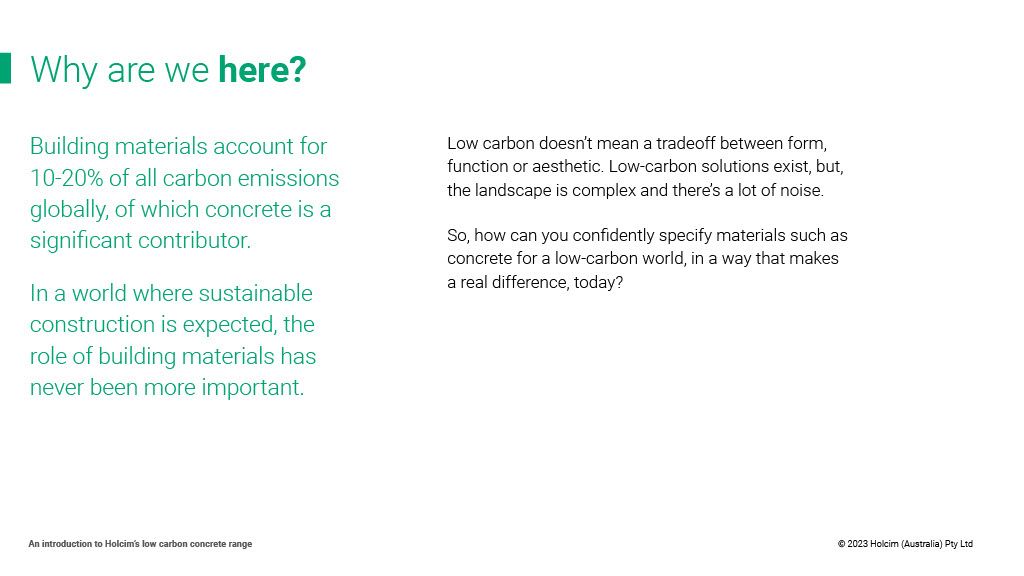
So why are we here? There's been in the past, especially within Australia, there's been so much focus on the post-construction side of things and embodied carbon embodied energy. However, there hasn't been a significant focus on the actual building materials throughout the construction phase. And when you think 10 to 20% of carbon emissions globally, come from building materials of which concrete is a significant contributor.
It is it's an area that we should be focusing on. We've had a packed in the market. Since I think April 2021. We're supplying to all states and regions, we're supplying into every single market segment you can think of from infrastructure to residential to renovations, so there's not a single market segment that ECOPact can't be supplied into. But when you think, think about concrete being a significant contributor.
Globally, if concrete was a country, that would be the third largest CO2 emitter, as a country, so for Holcim as the largest cement manufacturer in the world, we are very adamant about getting to absolute Net Zero. We're driving everything that we can do. We've got a large Innovation Center over in Europe, that does all the work for us and it is going to take innovation to get to absolutely net zero for us, and I mean, one of the things that blows me away, is one of the trials that we're doing at the moment. And this is the extent of where we're going to and the work that we're doing. We've partnered with a magnet company. And we're doing trials so far successfully on concrete that can charge your car as you're driving. So we run out, a stretch of road, we do some garage car parks where cars can just drive into the garage. And that concrete is charging the cars. So, when we talk about getting to absolutely zero by 2050, it is going to take all sorts of innovation, it's concrete, as we know it now is not going to be what concrete is like in 2030, 2040, 2050, but quite amazing.
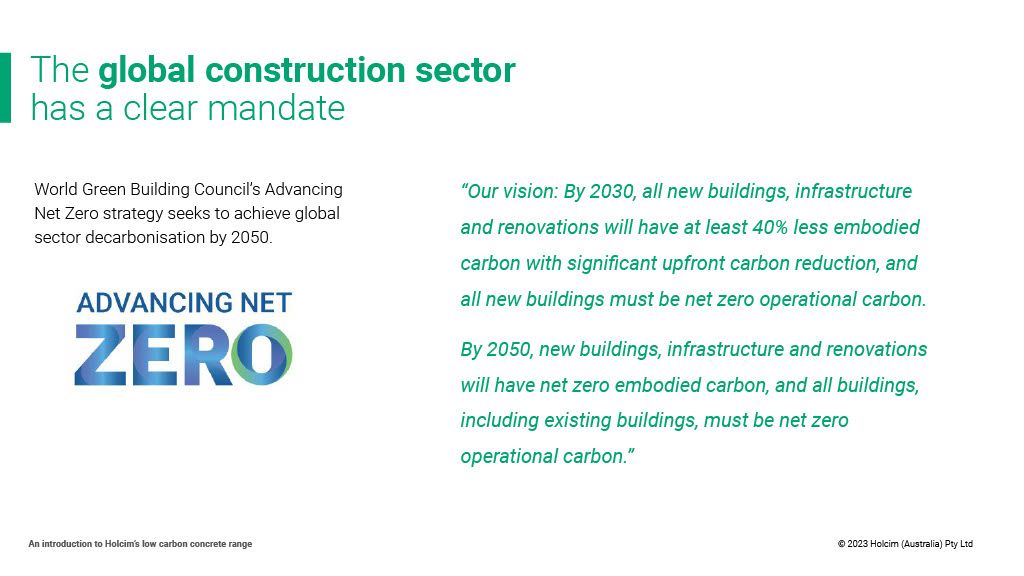
Look, I mentioned, we've had our 2030 and 2050 targets validated but the whole purpose of that was to align ourselves to the global construction sector, to try and work through exactly and be aligned with that, and the driving at the same direction. And for us, it's really important that every single conversation, like I said, everything that we do, not only just from a concrete perspective but our transport, our logistics, our operations at quarries, concrete plants and our precast manufacturing facilities. You know, we're switching over to solar, we're using electrically powered trucks, we're using hydrogen-powered loaders. So, it's not just about the concrete, it's about everything that we do. So massive focus for us.
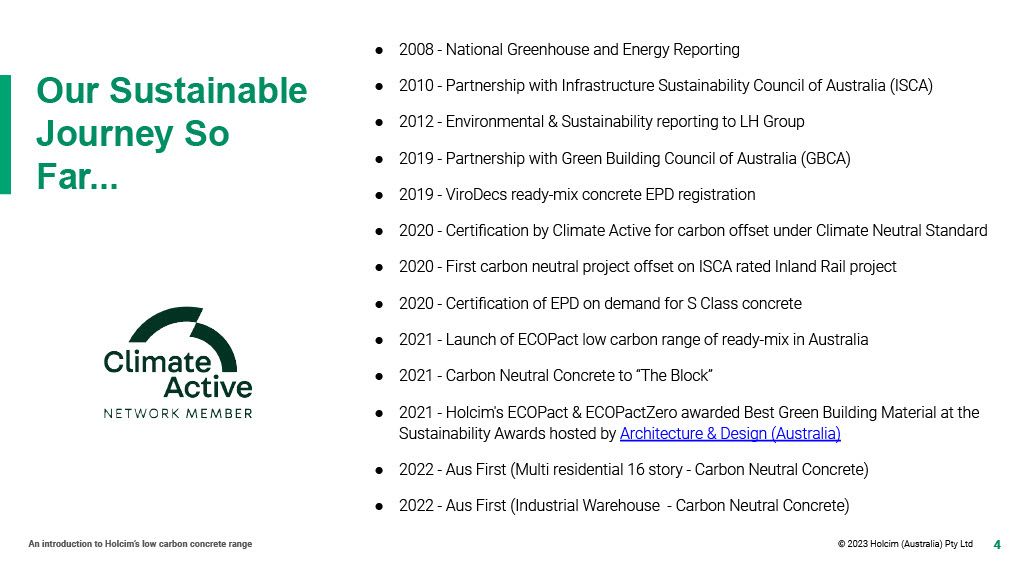
Back in Australia, not so much globally. It's important to list some of it or to note some of these milestones because sustainability for Holcim hasn't just been a two-year journey. You know, we've been reporting greenhouse and energy reporting, since 2008.
If you have a look here in 2019, this point here, Holcim Australia was the very first concrete company to go down the road of that full lifecycle assessment on our raw materials, to be able to have an Environmental product declaration quantify the embodied carbon within our concrete. So that was a two-year process, we did every single concrete plant in the country, and we've got about 190 to 200 2 year processes that we started in 2017.
That was critical for us because we needed to understand what our normal class conventional concrete and what the embodied carbon was in that, to be able to push the reductions as far as we can.
Then in 2020, we got climate active certification to be able to offer carbon-neutral,
Now, are offsets the way of the future? Definitely not. But it's a step in the right direction. And I think the biggest thing with building materials and sustainability and getting to absolute zero is those small steps. And then we've got to take those small steps to be able to get to where we need to get to. So, it is a step in the right direction. And you know, who would have thought five years ago, you could say, carbon neutral and concrete in the same sentence?
The key point, I guess, when I mentioned those two items is the transparency of everything. Holcim is very adamant that everything we do around sustainability and reporting and everything has to be fully transparent. So, we underwent these two processes before we launched ECOPact here in April 2021.
It was really hard and that first year, there's still a lot of myths out there about low carbon concrete not performing, taking too long to cure, all those sides of things. So, it was very much an education process running sessions exactly like this with architects, designers, engineers, consultants, home builders, developers, that type of thing.
You know, by the end of April 2021, we'd won the Best Green Building Material at the Sustainability Awards hosted by Architecture & Design (Australia) and we went on to win the Best of the Best at the awards, which was quite amazing to think concrete, featured as the best of the best.
A couple of other little milestones. So, I've got to update the slide deck with 2023 milestones, but you know, two key ones and I'll show you these projects at the end. 16-story, multi-residential projects, all carbon neutral concrete, as well as an industrial warehouse made from carbon neutral concrete, so some great milestones there.
And I guess it just signifies how important and how focused we are driving sustainability.
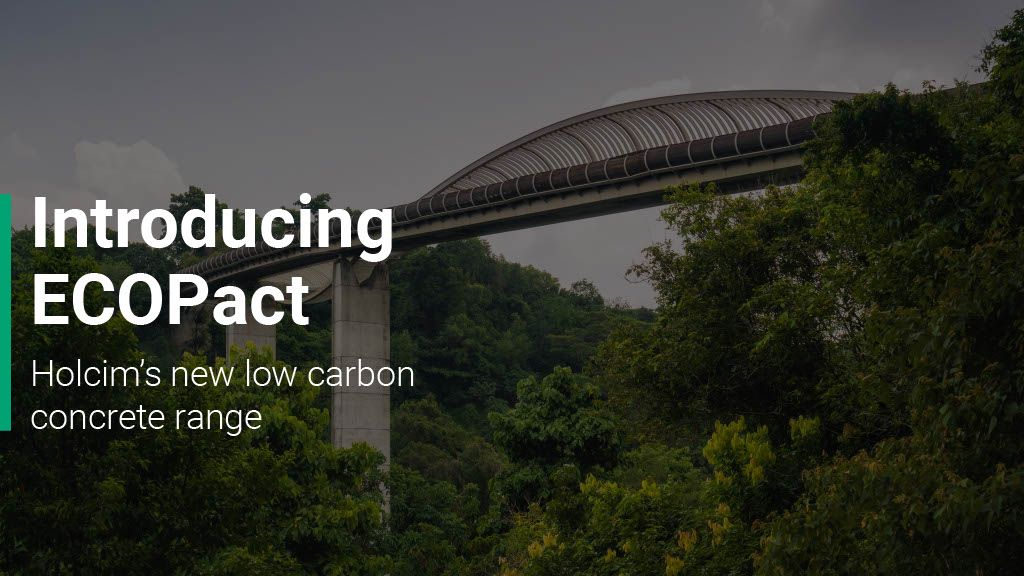
So, what is ECOPact?
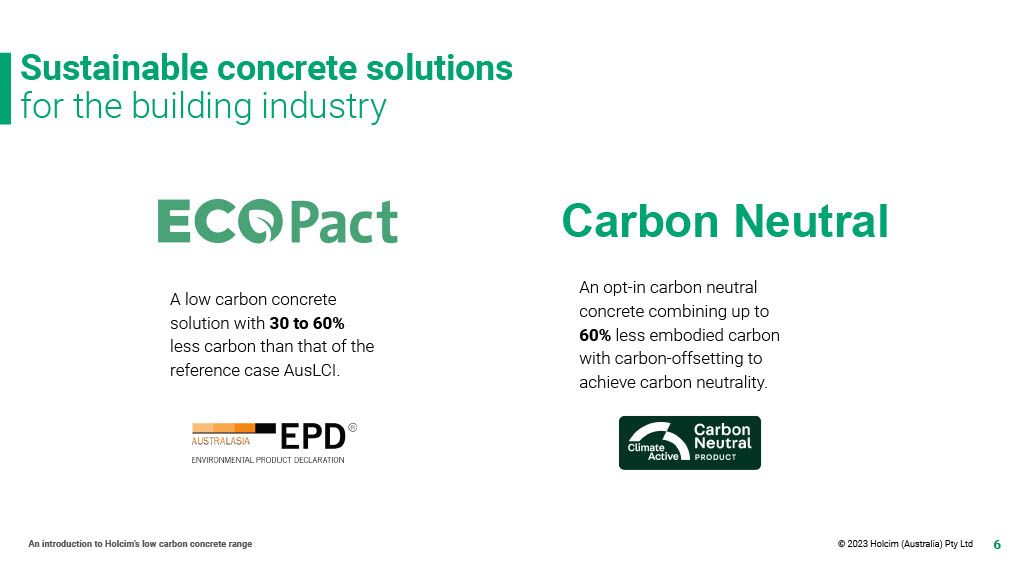
I guess in a nutshell, ECOPact is a low-carbon concrete, guaranteed to achieve that 30 to 60% reduction from the AusLCI reference case, all verified by an environmental product declaration. And I will show you the environmental product declaration a little later on, for those who don't know what it is. But the key message, is when we launched ECOPact, our commitment was that 30 to 60% reduction, we've only just finished the POUR, I think it was the 6th or 7th of December last year, with an engineer from Robert Byrd group, where we achieved an 81% I think it was an 81% reduction, which is quite amazing. So, when we launched two years ago, we were that 30 to 60% but we weren't, we didn't want to just sit on our laurels and leave it as that. Ever since then, we've been pushing the boundaries to try and get better reductions, maximize the performance, all that side of things. So, we've now successfully done 25 MPA concrete into the residential market, at an 81% reduction in embodied carbon which is quite significant.
When we launched and I mentioned climate active certification, we wanted clients to have the choice between low-carbon concrete or carbon-neutral concrete.
ECOPact Zero or ECOPact with the opportunity to opt in, or carbon neutral, is what we saying is the choice for customers to say Yes, I want carbon neutral concrete. Now, the key part of that message, this product here on the right is a service to Holcim purchase our offsets and bulk walkthrough, client active certification certified offsets and those offsets have been assigned to whatever the concrete is that goes out the door when a client wants carbon neutral concrete.
One key message and we had this very early piece is a couple of customers said, Oh, look, I've got specific mixers, but I just want to offset everything in them and have a carbon neutral concrete and that's one thing that we said we wouldn't do and we've stopped by that since we launched ECOPact, they must go hand in hand, you're not driving sustainability, just by purchasing hoops and offsets we have to our commitment is that you have to have EcoPact, we maximize the reductions first and it's only the remaining embodied carbon within the concrete mix that is then offset and that's getting lower and lower. Like I mentioned, we, you know, we got up to 81% reduction. So, you're only offsetting 19%. Now, it's quite amazing when you think about that.
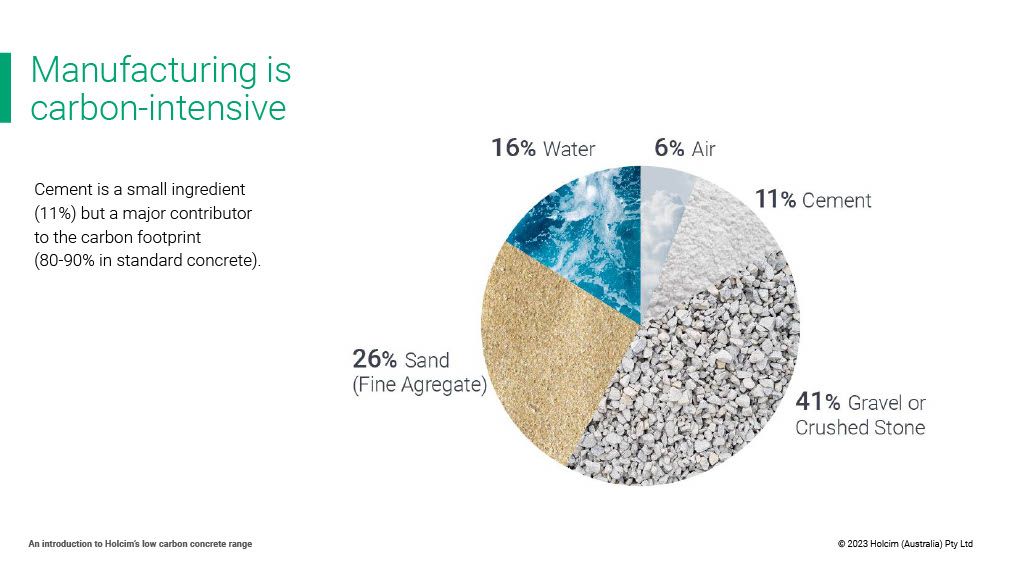
This is probably a key graph to understand the constituents within concrete. And you know, when you talk about the cement factor, that's our major focus. It's 11% of the overall concrete mix by weight but it's 80 to 90% of the carbon footprint within concrete. So, for us, yes, it is about reducing that. We reduce the cement component and include industrial recycled byproducts. We're doing tests and trials now, because we understand that those byproducts aren't going to be around forever, with counselling plates, and lithium matching all these other different byproducts that can be substituted for cement. So, we're doing trials now to make sure that when these byproducts are no longer available, we've got other supplementary cementitious materials to move on to.
So that's the cement side of things. And, you know, those myths around low carbon concrete doesn't perform the same as conventional concrete or it takes two hours longer to cure, or to set, those sorts of things. Admixture technology has come so far in the last five years, it's quite amazing. Concrete isn't just this gray stuff that goes hard, there's a science behind it. And we now, like I mentioned that Paul, the engineer from Robert Byrd group, that was driven, they were able to still pour that concrete, the concreter applies it, finished it was off that concrete in the same amount of time as conventional concrete, thanks to Admixture technology.
So, it plays a big part in low carbon concrete. And we work towards that. But then it's also about the aggregate side of things. Now, Holcim is an integrative business, we have our own quarries. So for us, it's very much putting the onus back on our quarries to say, what are you doing to drive to lower your carbon footprint, which will then lower the carbon footprint of the concrete? It's also about how we started to incorporate recycled aggregate back into concrete.
At the moment, I'm based in Brisbane, but at the moment, you know, we are taking all concrete return that comes back to the concrete plants is now getting put into bins and getting taken back out to the quarries is getting crushed, and going back into our concrete. Once upon a time that just used to go to the dump. So, you know, when a concreter onsite orders, three cubic meters or four cubic meters too much, that concrete has to go somewhere. What we're doing now as an organization, that's we're recycling.
In some parts of the country, like Victoria, Western Australia, we're taking demolition concrete waste, and putting that back in. So we can do that. New South Wales and Queensland we're starting to do trials with that. But it will be it's how do we use that recycled concrete from the demolition site and put it back into concrete. It's a bit of a fine line because when you talk about recycled concrete slabs, or whatever, from a site, it can only go back into the concrete at about a maximum of 15%. Because if you put, if you think of that concrete being crushed down, it still has a fine layer of cement dust around it. Now, as soon as you put that back into concrete, the water demand goes up. And with the water demand going up, so does the cement need to increase. So there's a fine line between using 100% or using recycled aggregates and reducing the embodied carbon, we've got to find that balance and that balance at the moment is about 15%.
Then we talk about the sands. Now, we've done a lot of work with our quarries, and we use manufactured sand across the country. That manufactured sand is a byproduct crushing of the aggregates.
What that does is that reduces the amount of virgin sand that we have to dredge up from riverways. So, we use manufactured sand now in 95% of our mixes, unless government authorities say no, you know there has to be a certain percentage of it. But what that's done is with all of that, manufactured sand, once upon a time just used to go into road base and it didn't meet the specification for sand or concrete. So, there's been a lot of work over the last 10 years to do that, into our precast mixes everything, we can use manufactured sand. There's not a single concrete plant in the country that can't do up to 100% recycled water. Unless once again, some main road authorities will say has to be 50% Town water, 50% recycled, but we can do 100% recycled water out of all of our concrete plants. So, it's when you think about it, it's that whole piece of the pie. It's every constituent that goes into it. Now, these are just the products that we are in control of, obviously, there are admixtures, fibers, oxides, and all of those different constituents that go into that we purchase to go into our concrete, we're also holding out third-party suppliers to account you know, have you got an EPD? What are you doing around sustainability? How can you reduce your carbon footprint which in turn helps reduce our carbon overall concrete carbon footprint? So, it's working with all key stakeholders to make sure that we're driving sustainability and pushing and lowering embodied carbon as much as possible.

So why ECOPact? It's a low-carbon alternative to conventional concrete that reduces the embodied carbon between 30 to 60%. Standard cement content is replaced with those industrial byproducts and it's available in a range of optimized strengths and mixes. So, you think, from 20 MPa, all the way up to 80 MPa concrete, nonstructural, structural, you know, we're doing with supply 200,000 cubic meters of ECOPact into the Melbourne Metro project.
We're supplying precast market segment, we're supplying commercial, we're supplying decorative concrete. So, whatever the project is that you're working on and with the focus is on sustainability, which every project should be, right now, because we've got a long way to go to absolute zero by 2050. We reach out and touch base with me, because we can design the mix to do whatever you need it to do, as well as reduce the embodied carbon.
The key point here is this one hand down the bottom, it's placed, pumped and finished, exactly like conventional concrete. The concrete placer should not treat it any differently. They do everything the same when they place it, they still have to cure it, and they still have to go through all of those processes that they would normally do with conventional concrete. You know, we've done a lot of pours, but one situation that comes to mind is, and the case study, I'll show you, it's the multi-residential case study that I'll show you at the end, the actual director of the developer reached out the day before a 700 cubic metre pour to say my concrete is very nervous to use your low carbon concrete he’s worried he's going to be there till midnight, you know, 700 cubic meters, that was the very first pour, that they major pour, they did. Now that concrete or by the time he had pumped, placed and finished and done everything with that concrete, he was in the same amount of time as he would have been placing in conventional concrete two weeks before that.
So, it's trying to bust all those myths where a contractor will push back on the architect, the engineer saying, I'm not using low carbon concrete, it doesn't work, the set times terrible, it's ridiculous, you can't do that. That's false. That's, that's no longer true. Holcim isn’t the only one with low-carbon concrete. There are more and more concrete suppliers out there doing it, and who have been doing it for roughly the same time as us. So, it's there, you know, if we're supplying 200,000 cubic meters of it into Melbourne Metro, now, that has to take all big roads, boxes that have to meet all of the certifications, they wouldn't be taking it if it didn't perform as it should.
The last point is there's the option to opt for carbon-neutral concrete.
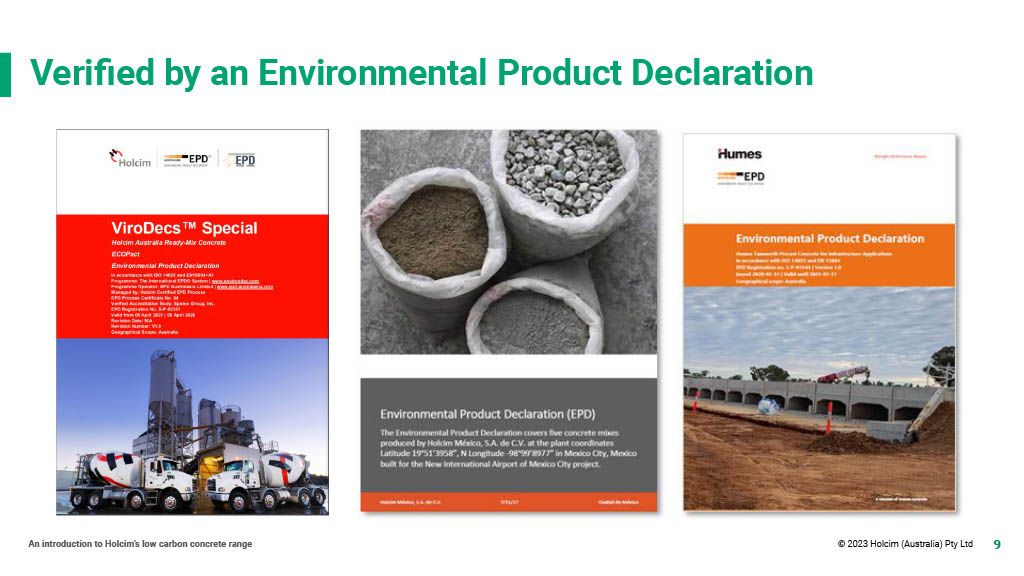
Environmental Product Declarations
There are a lot of you on this call, I don't know what your knowledge is, some of you may well be aware of Environmental Product Declarations, and some may not. But when you think about it, from a concrete perspective,
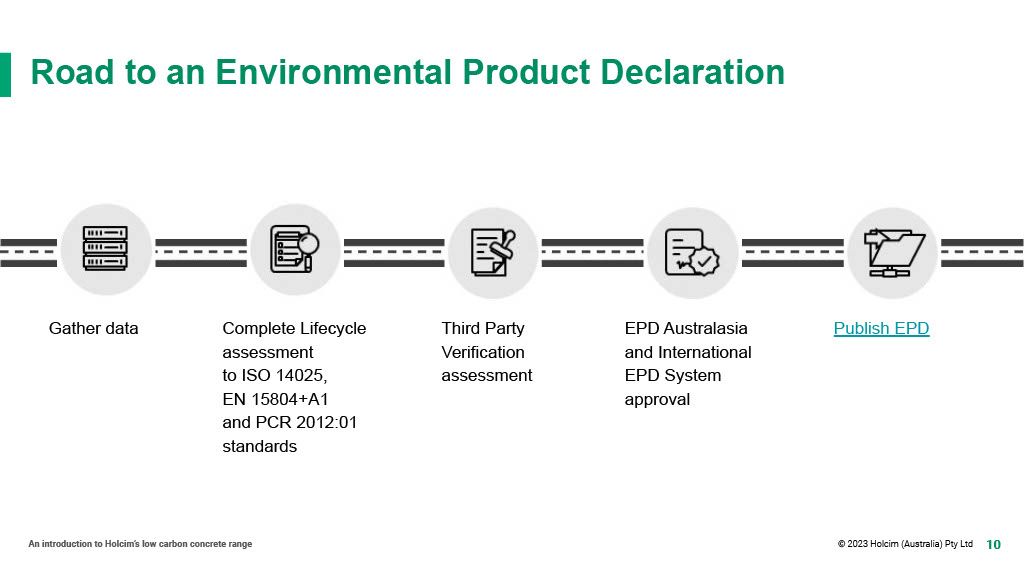
It's a massive amount of work to go into gathering all the data. Now you think about the full lifecycle assessment on all of the processes and the materials, raw materials that go into concrete, we had to gather all that data. That was back in 2017. So, you're talking about, you know, the drilling rig that drills at the quarry to, to detonate and blow up the side of the quarry so that we can crush that big rock down to small rock, all of that data is gathered. From the very first let's say drilling and blasting at the quarry to when the concrete leaves the gate. So, if you can think of all of those processes, you know, like I said, the truck movements, the crushing of the aggregate, the batching of the concrete, all the raw materials, all of the embodied carbon from all of that processing is then put into a lifecycle assessment to meet specific standards, then third party verified, and then uploaded onto EPD Australasian website. Now I'll just show you one example here. But if the environmental product declarations aren't familiar to you. I would highly recommend all architects, designers, and engineers use this as a bit of a guide to understand what suppliers can quantify the embodied carbon within their products and what suppliers can't.
So what it does, is it shows you all the latest environmental product declarations, all sorts of products.
But if we type in Holcim, it'll bring up all our EPDs. The key message here is, for us, Holcim opted to do our EPDs up by region. So, Queensland Gold Coast, Western Australia Southwest Region, Queensland Darling Downs, all of the regions are done based on the raw materials supply. So, all of Brisbane uses the same raw materials, Sunshine Coast uses the same raw materials, and New South Wales Illawarra, in our region, they use the same raw materials.
Let's have a look at Victoria. So this is the Holcim Victoria ECOPact Environmental Product Declaration, you can download it.
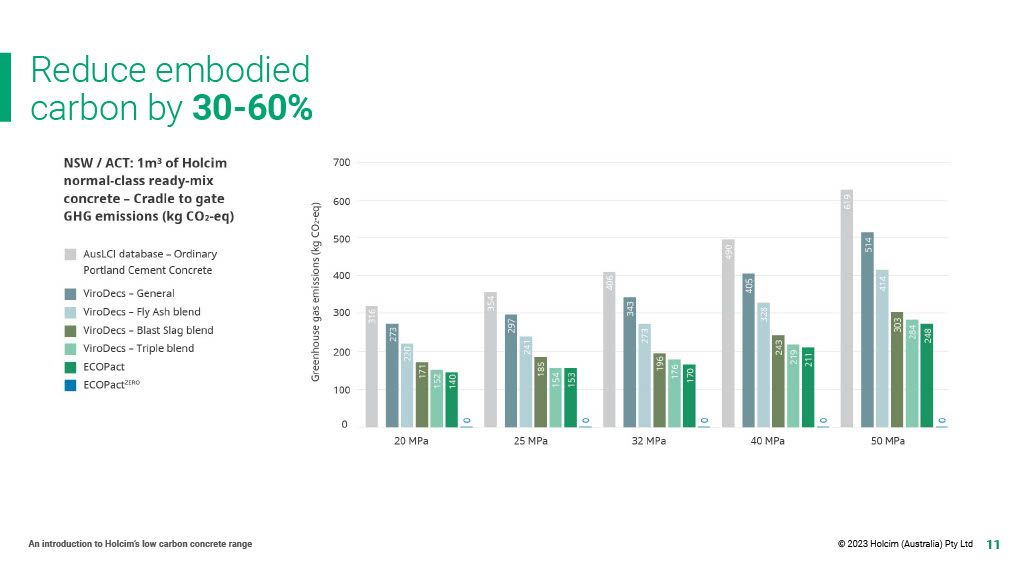
This is a graph and this was this graph was done up when we first launched. So, if you look along the bottom, these are the different strength grades.
The vertical axis is your kilograms of CO2 emissions per meter cubed. How we were able to work on this 30 to 60% reduction. It's all based on the old AusLCI reference case. Now this light gray line is the reference case.
All these other mixes here are Holcim mixes by the last two before launching our low-carbon branch. I guess the important message here is Holcim has been driving this sort of technology for a very long time, the last 15 to 20 years we've been substituting cement with Fly Ash and Blast Slag because we know it's more sustainable. So we've been doing that with not all our mixers but most of our mixers so if you have a look here, let's look at the 32. 406 kilos is the reference pass.
Then we start introducing those byproducts. This next one is the Fly Ash blend. What that means is it's got fly ash and GP cement. As you can see, it comes down to 273kg. The next one there is Blast Slag only with GP cement coming down to 196kg. So, all these different supplementaries have different carbon footprints. As you can see, once we combine the two, this is called a triple blend, it's a combination of cement, fly ash and slag in that mix, and we get down to 176kg. That's what we're able to do in New South Wales ACTB
When we launched the first lot of EPDs we did, our ECOPact, we got down to 170 kilos. We're now at a point, as I mentioned, this graph was done when we launched in 2021, and we're now at a point where we're well exceeding some of these numbers here. In some parts of Victoria, we've got mixes that only have, you know, 20% cement in it, and that 80% is supplementary cementitious. And that's VicRoads approved and being supplied now, into piling projects across Victoria and Melbourne. So quite amazing.
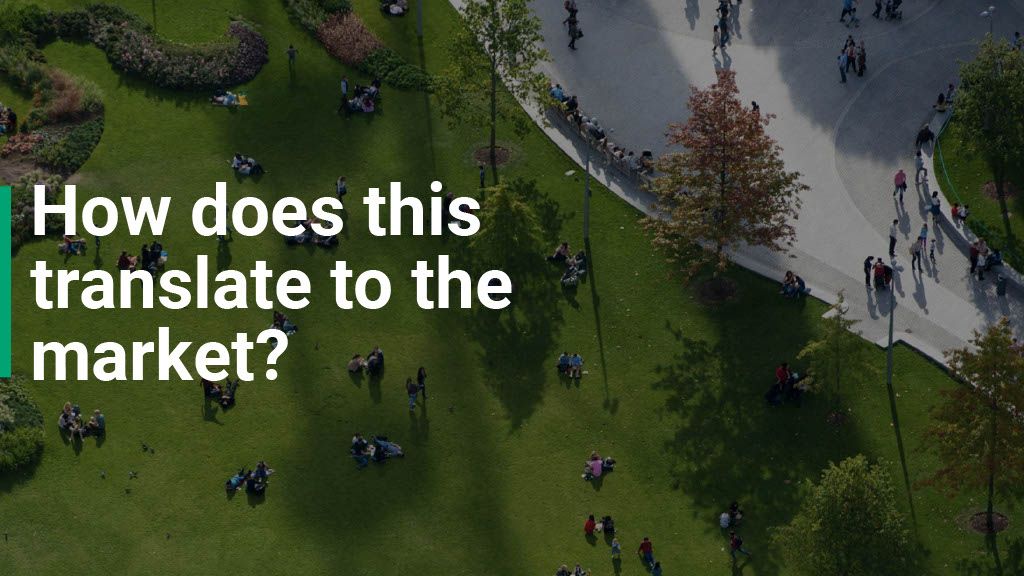
How does it translate into the market?
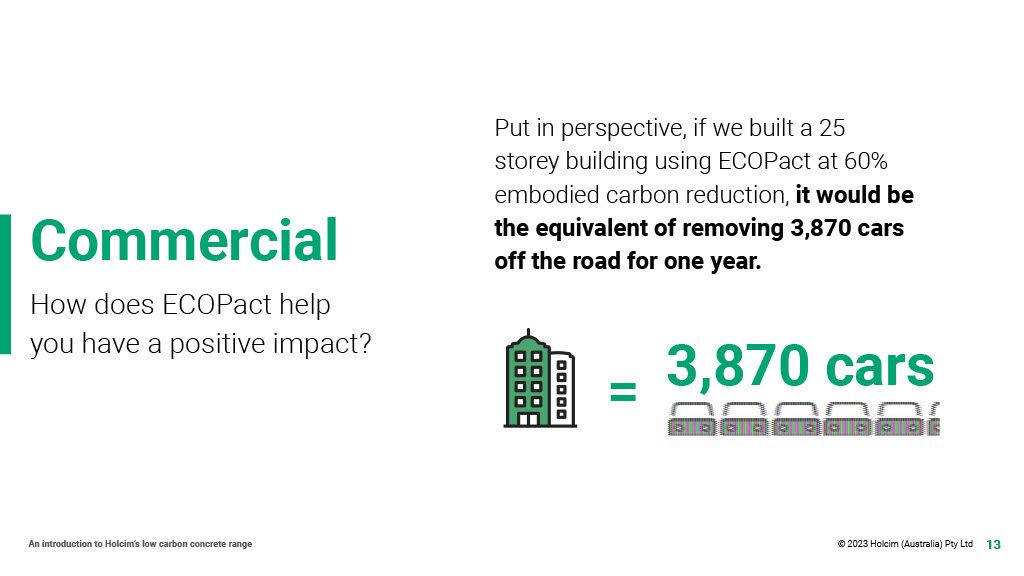
Put into perspective, you know, just one commercial project, 25 Storey tower, using ECOPact, the 60% reduction, equates to 3870 cars off the road for a whole year. Not a day, not a month, a whole year. So substantial, you know, it's a very simple slide. But that message is very powerful.
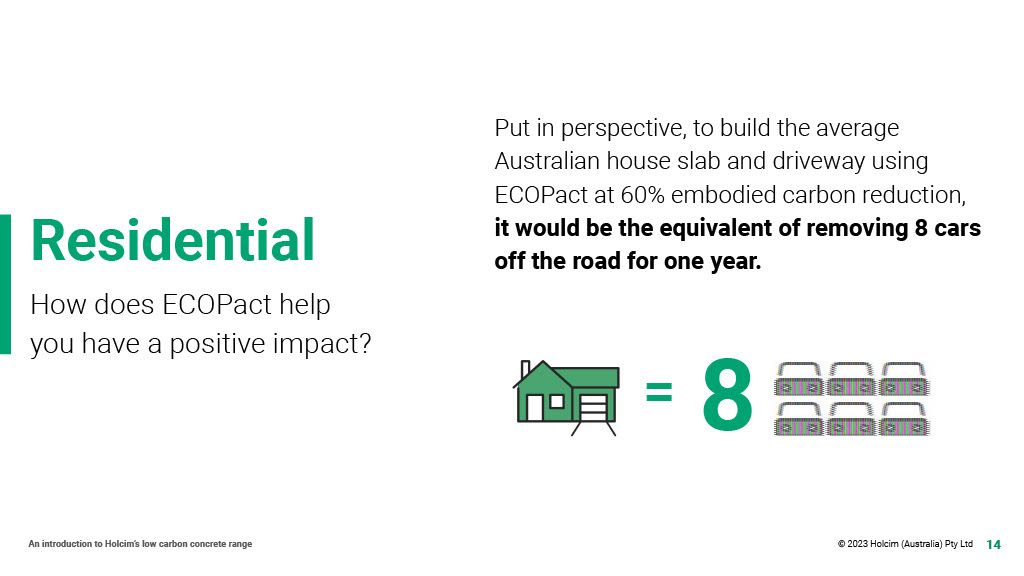
Residential, so eight cars off the road for a year, just for a typical house slab and driveway. You think about some of those volume builders who do 2000-2500 houses a year, the difference they would make if they switched to a low carbon concrete. We’ve had a lot of conversations with, you know, some of those high-volume builders that we have contracts with across the country and up until probably mid-last year, or maybe the March last year, there wasn't a calling for it, or those builders didn't have clients asking for sustainability to be a major focus in their build. We saw that shift between March and July last year, where we had some of those high-volume builders starting to say, hey, we've got clients asking for low carbon concrete, we've got clients asking for us to factor sustainability into their build, which is amazing. So, there's a number of them that are converted over to ECOPact
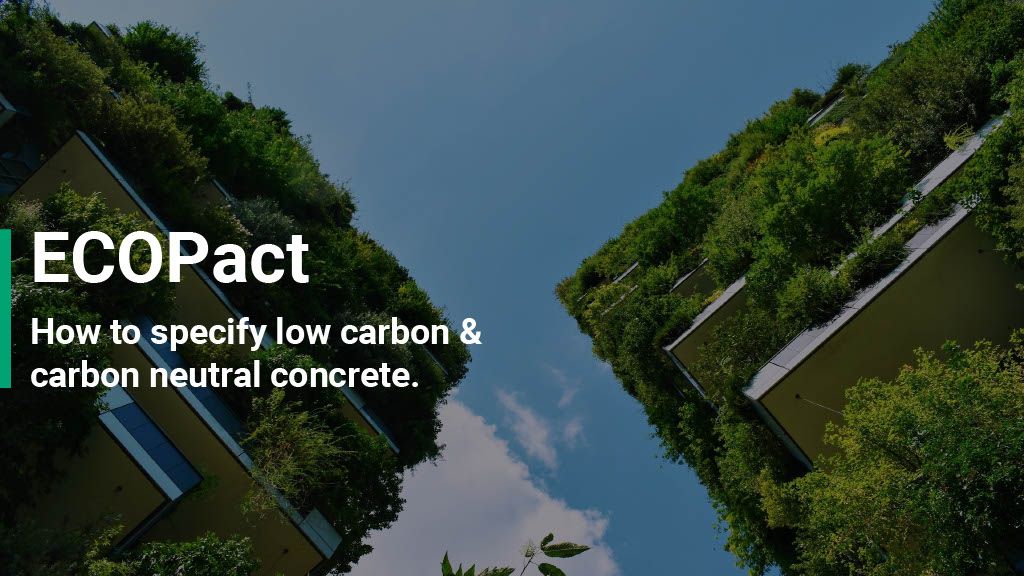
How to specify
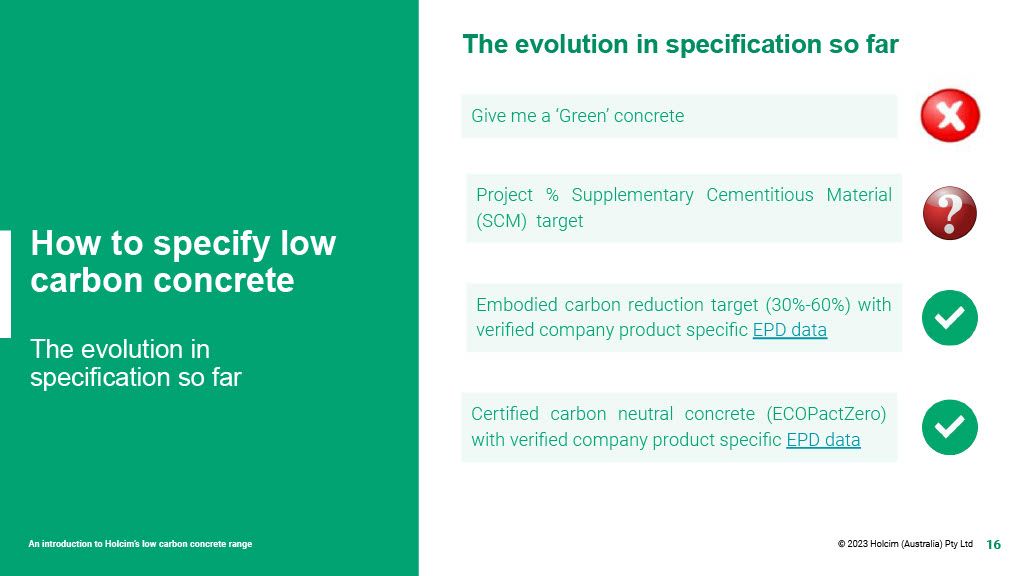
This is probably a good message for everyone on this call. Now it used to be just give me green concrete, I don't care what's in it, I've got to tick a box for me to win a tender.
Still, that's well and truly outdated. It's all about the numbers now. Project percentage supplementary, a lot of the main road’s contracts and the government contracts still have that factor in. But you can't quantify embodied carbon, they just focus on that as a specification. The way we've been driving it since we launched is having an embodied carbon reduction target, be it 30 to 60%, or 40% for the total project, whatever that target is, have a target in mind. And then always make sure it's verified by a product-specific EPD. And that's regardless of if it's concrete supply or any other building material. I think unless the supplier can provide an EPD, how do you know how sustainable the product is? That's probably the biggest message out there.

These are some great examples of specifications that we've already seen come through. All of these have been from I think 2022 and one of them was from 2023. So quite amazing, when you think there are architects and designers out there now or back in 2022, that is delivering that message and calling for low-carbon concrete or carbon-neutral concrete.
We love seeing Holcim in specifications that we love seeing. ECOPact and ECOPact Zero. But the key message is, if for whatever reason you do council work or government work and you can't put a supplier, you can't put a brand in there, ask for carbon-neutral concrete. There are so many specifications out there now that are calling for carbon-neutral concrete, which is absolutely where we need to be. Verified, make sure it says verified by an environmental product declaration. That's probably the biggest key. Make sure suppliers are being held to account and can demonstrate the embodied carbon.
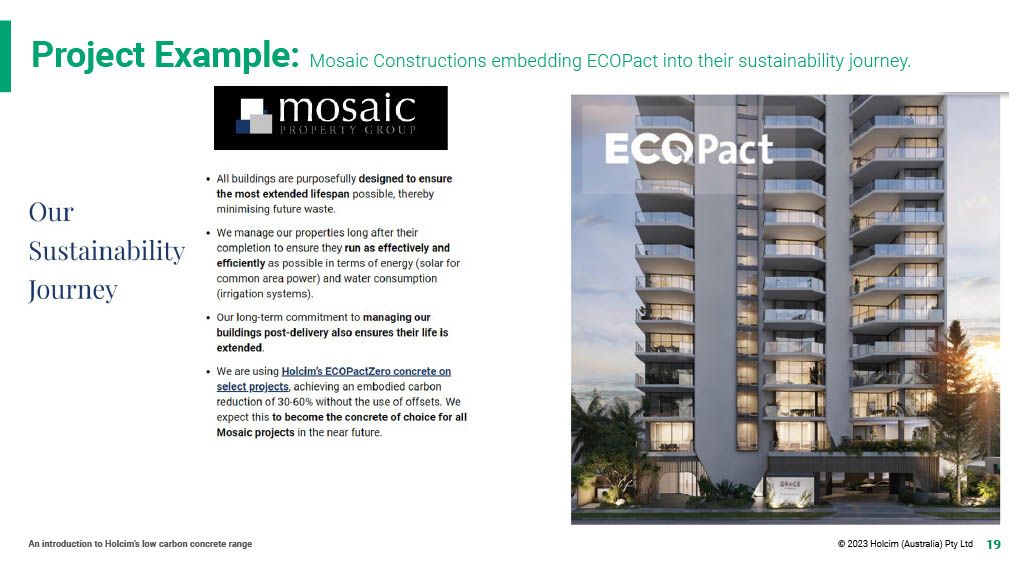
So two case studies before I wrap up and then we can jump into questions.
This is the project I mentioned that was a 700 cubic meter pour that started with the director reaching out to me. Now when you think about the concrete that goes into here, that was 40 MPa concrete by the way. There's 20 MPa, all the way up to 80 MPA concrete in this structure. The post-tension, every single one of these slabs had to achieve 22 MPA in three days.
There are 60/65 and 80 MPA vertical column mixes, self-consolidating column mixes so they don't need to be vibrating. So, there's less petrol fumes and all that from the concreters using vibrators on site. So, we can design self-consolidating precast or vertical element concrete that has a low carbon footprint as well.
I think probably the best message out of this one is not one single day - this project stuck to its schedule. It didn't go over time; concrete didn't cause this project to miss its schedule and be five days overdue. Everything went to plan. Now, if you have a look at Mosaic, in Southeast Queensland, they do projects on the Sunshine Coast, Brisbane, and the Gold Coast, they don't target GreenStar. They are driving sustainability because it's the right thing to do. They've now, as mentioned here, they use ECOPact across the board. For all their projects, they probably do 10, maybe 12 of these developments every single year. This project was completed in 2022.
So that, hopefully, brings some competence in what we're doing with low-carbon concrete.
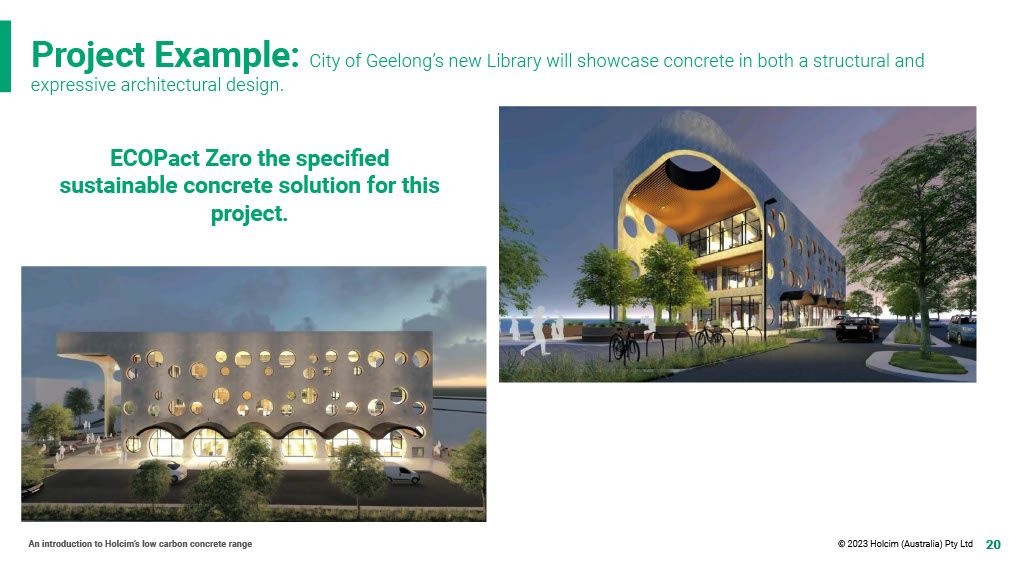
City of Geelong library, we put this in as a case study because it's all about early engagement and collaboration. And it's, it's new, well, it was new for a lot of us driving sustainability back in 2021/2022 and now they it's the forefront of everyone's mind and we've got to be taking those active steps and reach out to suppliers, have that conversation, do you have low carbon concrete? If so, let's pull it together and have a key stakeholder meeting and we can talk through exactly what your project is, what the concrete requirement is, and then how we can design that low-carbon concrete that's going to help you achieve all the aesthetic side of things, as well as performance on the structural side of things and meet the ESD components as well.
There were six months’ worth of meetings, key stakeholder meetings in this project where I did a similar presentation to this. Off the back of that one of the architects reached out and we started having a conversation about this project. From there, we had once a month key stakeholder meeting, where we ticked off the box from a structural engineer's perspective, and an ESD consultant's perspective, and then we sat down and wrote the spec together, protecting myself for all the different concrete components.
That's what it takes, we've got to work through, got to have that engagement and as an architect, designer, and engineer, having a conversation with suppliers, they can help bring to the forefront of your mind what innovations are out there. You know, we just Holcim, as an example with ECOPact, we now have ECOPact Max. That is plus 70% production, ECOPact is active which has reduced shrinkage. There are all these different products coming out of their tests and trials that unless you ask the suppliers or have those conversations, you guys aren't going to know they're out there. It can help your projects - like with this project precast elements that hadn't factored in using self-consolidating concrete. Now that's saving in costs, time, labour, as well as embodied carbon through not using vibrators and all that sort of stuff. So, it's just working and having those conversations that's the key message.
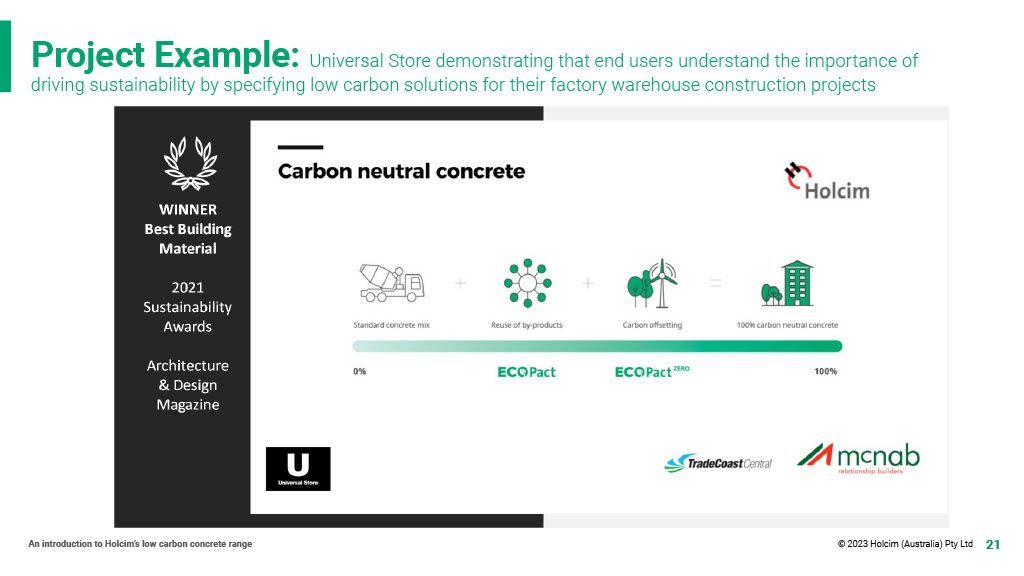
This case study is an industrial warehouse. This was the consumer that reached out to us. So Universal Store, the clothing brand, had heard about ECOPacts and all going carbon neutral concrete with ECOPact and I reached out and we started having the conversation and they asked us if would we be prepared to talk to their developer and the principal contractor on site and, of course, so we started those conversations, went through tests and trials. This was the very first industrial warehouse that used 100% carbon-neutral concrete so maximum reductions first.
In the burnished internals, the tilt panels, and the external hard stand area. So, there was a lot of testing and trials. What we agreed to with both the contractor and the developer is that we run these trials, and let them trial the mix. We went through quite a lot of processes for that. But that's what it takes sometimes, you know if you have a significant project like this, concrete places, concrete suppliers need to be able to demonstrate that low carbon concrete performs the same as conventional concrete.
That project is finished now, Universal Store has moved in there. It's their head office. They've had several other contractors come through and have a look at it and we're now across Queensland and Victoria. I think we've supplied maybe about five or six now. Warehouse projects, fully internal, external, with fibers or no fibers, which is amazing. So, this was the very first one to kick it off, which was great.
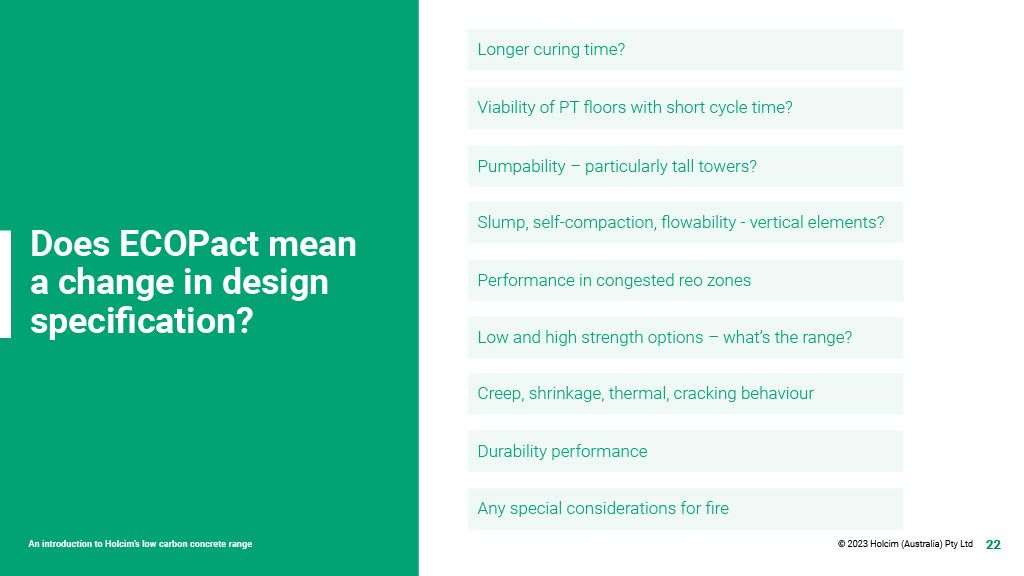
This is the last slide. So, when, you know, ECOPact means a change in design specification? No, it doesn't. I think everyone knows that a prescriptive specification is going to be very hard and we need to step away from prescriptive specification and look at performance base specs to specify what you want the concrete to do, you don't need to specify what goes into it, will make sure that concrete does what you want it to do, whether it be shrinkage, whether it be early age, strength, all of those things.
In 90% of presentations that have been done, these questions have come up.
Does ECOPact have a long curing time? No, it doesn't.
Viability for PT floors with short cycle times? Absolutely. We can do it. Even in Victoria with that climate. We're doing ECOPact active down in Victoria where they're achieving a minimum of 22 NPA in three days. Queensland we've been doing it here since 2022.
Pumpability particularly in tall towers? No, no, we have a special pumping tool that tells us we can plug in the data, including the pump, how many bends are in there? We can tell the contractor on site, the pumping pressure that this mix is going to deliver and how far it can go.
Slump self-compaction flowability - I mentioned self-consolidating.
Concrete performance in congested reo - Absolutely not. We would put forward self-consolidating.
Low strengths and high strength options - 20 MPA all the way to 80 MPA.
Creep, shrinkage, thermal, and cracking behaviour - it's no different to conventional conflict. From a durability perspective, we have seen better results with the ECOPact than we have with conventional in some cases. So, there's not one aspect here that ECOPact doesn't tick the box on.

So those myths about low carbon concrete not performing, it's hard, you know, some concreters have been in the game for 30-plus years. They liked their mix, and they don't want to change their mix, but it's up to us, suppliers, and specifiers to be driving it and pushing it. Ask the builder, if the builder doesn't want to use it and says they have had a bad experience with that five years ago, put them in contact with us, I'm more than happy to have a conversation with them and do a test or trial. It's all about that education process.
That's it from me.




 Indonesia
Indonesia
 New Zealand
New Zealand
 Philippines
Philippines
 Hongkong
Hongkong
 Singapore
Singapore
 Malaysia
Malaysia







